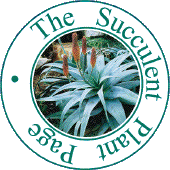 
Glossary of Botanical TermsTo locate the word in which you are interested:
|
A B C D E F G H I J K L M N O P Q R S T U V W X Y Z
Click on a letter to see definitions of all words beginning with that letter.H
Habit - the general form and growth pattern of a plant.
Habitat - the place in which a plant, or other organisms, naturally grows or lives.
Hair - a long thin epidermal appendage, either formed from a single elongated cell or consisting of a single row of cells.
See also: arachnoid, barbate, canescence, capillaceus, capillatus, ciliate, cephalium, coma, felt, glabrous, glochids, lanate, lasiacantha, penicillate, pubescent, pubispina, scabrous, trichome, villous, woolly
Hairy - with a covering of hairs.
Half life - the time taken for the value of something to reduce to half of that value. Of a radioactive isotope, the time taken for half of the atoms to decay.
Halophyte - a plant adapted to, growing in and tolerating salty environments.
Haploid - having a single set of chromosomes.
Haptonastic - a movement response to a touch stimulus.
Hard Water - contains salts (usually calcium or magnesium) that interfere with formation of a lather from soap. Hard water used for irrigation of plants may leave white marks on foliage and the salts accumulate in the soil.
Hardwood - strong, dense wood from slow-growing broad leaved trees.
Hardy - of a plant able to survive the extremes of climate, often taken to mean resistance to cold and frost.
Haulm - the collective stems or tops of crop plants (e.g. beans, peas, potatoes, grains, grasses) after the crop has been gathered, as used for bedding or thatching. Occasionally applied to a single stem.
Haustaurium - (Pl. haustoria)- a specialised organ through which a parasitic plant absorbs nourishment from its host.
Heath - open land covered with low-growing shrubs such as heather.
Hectare - (ha) a metric unit of area equal to 100 Ares (2.471 acres) and equivalent to 10,000 square meters (107,639 square feet).
Hedge -
Hedgerow - a border, fence or boundary formed by a row of closely planted shrubs or bushes often trimmed to a formal shape. The number of species forming a hedge tends to increase in proportion to its age.
Heel - a small portion of the previous year's growth at the base of a cutting.
Hemicellulose - heterogeneous mixture of polysaccharides resembling cellulose, but of lower molecular weight and less complex. Hemicellulose is insoluble in hot water or with chelating agents, but can be extracted with dilute aqueous alkali. Present in allmost all plant cell walls where hemicellulose binds with pectin to cellulose to form a network of crosslinked fibres, but found especially in woody tisues. Includes xylan, glucuronoxylan, arabinoxylan, arabinogalactan II, glucomannan, xyloglucan and galactomannan.
Herb - a vascular plant lacking a woody structure.
Herbaceous - dying to the ground periodically or lacking a definite woody structure.
Herbivore - an animal that eats only plants.
Hermaphrodite - with both male and female reproductive parts usually in the same flower.
Heteromorphus - with an irregular or unusual shape or structure.
Heterotroph - an organism that can not make its own food and consumes other organisms to survive.
Heterozygote - with unlike genes on any particular pair of chromosomes.
Hibernation - spending the winter months in a resting or dormant state.
Hilum - the small scar on a seed coat where it was attached to the seed pod by the funicle.
Hirsute - pubescent, with coarse, stiff hairs.
See also: arachnoid, barbate, canescence, capillaceus, capillatus, ciliate, cephalium, coma, felt, glochids, lanate, lasiacantha, penicillate, pubescent, pubispina, scabrous, trichome villous, woolly
Holistic - of, concerned with, or dealing with whole or integrated systems rather than with their parts.
Holotype - the type specimen of a taxon as designated in the author's description.
Homology - having the same phylogenetic origin, but not necessarily identical form or function.
Homonym - a name that already exists for another plant. The newest name is illegitimate and must be changed.
Homoplasy - of different species with similar characters that have evolved separately and are not from a common phylogenetic origin.
Homozygote - with identical genes on any particular pair of chromosomes.
Hooked - with a straight basal portion and a tip curved into an arc.
Horticulture - the science of growing plants for decorative effect or for consumption as food.
Horizonthalonius - with a flat, level disc.
Hormone - a chemical substance produced in a plant tissue, capable of diffusing or transport to other parts where it's presence or gradients regulates specific functions such as abscission, differentiation, flowering, growth and tropisms.
Hort. - as part of a species name means "associated with gardens," "of garden or horticultural orgin". Usually applied to a selected form or cultivar or hybridised so that the true origin is obscure.
Host - the organism on or in which a parasite lives and from which it derives its nourishment. Sometimes also used for the plant on which an epiphyte lives.
Humus - the organic component of soil, composed of partially or completely decayed plant and animal remains that provides nutrients for plants and increases the ability of soil to retain water.
Hyaline - translucent.
Hybrid - progeny from an inter-specific (or inter-generic) fertilisation, often of intermediate appearance to the parents.
Hydathode - a specialised gland or pore on the surface or leaf margin of higher plants that exudes water from the plant tissues or in some cases can absorb water on the leaf surface.
Hydrotropism - bending, growth or movement of a part in response to a water source.
See also: Tropism.
Hypanthium - a cup-like, ring-like or tubular base of a flower carrying on its rim the calyx, sepals, petals, and stamens and often superior to the ovary.
Hypanthodium - an inflorescence composed of an aggregate of flowers on the inner fleshy wall of a concave capitulum e.g. Ficus or the characteristic flat "shield flowers" of Dorstenia.
Hyperplasia - an excessive multiplication of cells.
Hypocotyl - the main axis of the seed embryo just below the cotyledons and continuing into the developing primary root of the seedling.
Hypodermis - a layer of cells below the epidermis.
Hypogeal - happening, living or remaining below ground. Of the emergence of cotyledons below the surface of the ground or within the sead coat.
Hypogeous - below ground.
Hypostase - a basic substance, a group of specialised thick-walled cells between the ovule and the vascular bundle, a disk of woody, lignified tissue at the base of the ovule in some plant families.



